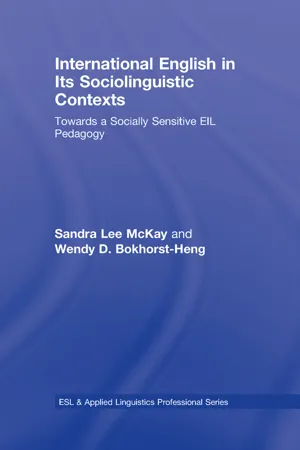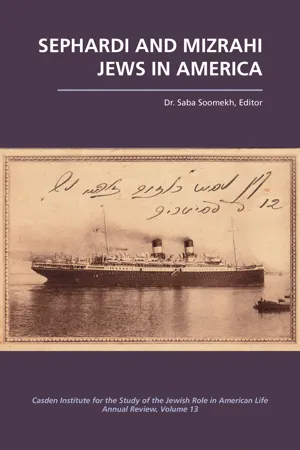Diglossia
Diglossia refers to a sociolinguistic situation where two distinct varieties of a language are used in different social contexts. One variety is typically used in formal or official settings, while the other is used in informal or everyday communication. This phenomenon is often characterized by a clear division of functions and prestige between the two language varieties.
6 Key excerpts on "Diglossia"
- eBook - ePub
International English in Its Sociolinguistic Contexts
Towards a Socially Sensitive EIL Pedagogy
- Sandra Lee McKay, Wendy D. Bokhorst-Heng(Authors)
- 2017(Publication Date)
- Routledge(Publisher)
...These choices are not random, and are largely connected to the linguistic norms, values, and practices of the sociolinguistic context of the particular speech community. In his seminal article published in 1959, Ferguson introduced the term Diglossia to describe a community where two or more varieties of the same language have different roles to play in society. For example, Singapore English can be described as an example of such classic Diglossia : SSE (Singapore Standard English), the H-variety similar to the standard variety taught in schools; and SCE (Singapore Colloquial English, or, Singlish), the L-variety widely used in informal situations and acquired informally (Gupta, 1992). Fishman (1967) extended Ferguson’s classic Diglossia to other multilingual situations where two mutually unintelligible languages occupy the H and L niches. In such extended Diglossia, the notion of domains is important. According to Fishman (1972), domains are used to explain “who speaks what language to whom and when in those speech communities that are characterized by widespread and relatively stable multilingualism” (p. 437). Domains include, for example, the family, religion, education, government, friendship, and so forth. What makes a bilingual situation diglossic then is that the linguistic differences must be function- ally distinguished within the particular society. They are also typically in hierarchical relation to each other, with one representing power, prestige, purity, and so forth. The H-language is used in the formal domains. For example, Sanskrit in India is used for religious, educational, literacy and other such formal domains. In contrast, the L-language (e.g. Kannada in India) is rarely used for such purposes, being only used for more informal situations, such as local markets and conversations between friends. Other researchers (e.g...
- eBook - ePub
- Gerard Van Herk(Author)
- 2012(Publication Date)
- Wiley-Blackwell(Publisher)
...This is known as Diglossia (Ferguson 1959). In diglossic situations, the high (H) variety is used in formal situations, the low (L) variety among friends. What really makes Diglossia Diglossia is that you can’t mix a bit of one language and a bit of another (reminiscent of the co-occurrence restrictions in Javanese mentioned in chapter 9). The choice of which language to use is highly constrained by the social context of use, or domain, and these constraints are fairly similar across diglossic situations. Sometimes the use of a language in a particular domain is required by law (see a broader discussion about how societies officially regulate which language should be used where in chapter 13). Usually, though, diglossic situations arise through generations (or centuries) of societal multilingualism, multiple languages co-existing in a single community. H language is usually found in formal domains, including classroom lectures, formal religious rituals, literature, government, law, newspaper editorials, and TV news. L language is usually found in informal domains – the home, the schoolyard, the market, the street, newspaper cartoons, and jokes. H language is for strangers, bosses, and teachers; L language is for family, close friends, and subordinates. The original conceptualization of Diglossia required the H and L languages to be related, either fairly closely (as with Standard German and Schwyzerdütsch in Switzerland, or Standard and local Arabic (darija) in Morocco) or more distantly (as with French and French-based creole in Haiti), and for the H language to be largely school-learned, rather than natively acquired...
- eBook - ePub
Language, Society, and New Media
Sociolinguistics Today
- Marcel Danesi(Author)
- 2020(Publication Date)
- Routledge(Publisher)
...Wherever Diglossia exists, H forms are used typically for formal purposes (education, official communications, etc.); L forms are employed instead for everyday talk and informal discourse (humor, folk stories, and the like) (Trudgill 1983). In Greek, for example, demotiki refers to the code that evolved naturally from Ancient Greek, whereas katharévousa was a code that was artificially raised to the official standard until 1976, at which time demotiki became the official standard language of Greece, leading to a breakdown in the classical diglossic situation in that country. Table 3.2 summarizes the foregoing discussion. Table 3.2 Classical Diglossia Low dialect High dialect low prestige high prestige intimate communication formal communication group solidarity social authority and power mainly spoken part of literacy traditions informal formal usually a native code usually a learned code passed on in community passed on through schooling Diglossia implies that the perception dialect speech is hardly arbitrary; it is interpreted socially (Sayahi 2014). It is thus an important sociolinguistic notion. Today, the notion of critical Diglossia has become a target of sociolinguistic research (Saxena 2014). In contrast to classical Diglossia, which involves a historical assessment of dialect prestige, critical Diglossia maintains that the assignment of prestige is an ideologically-based process that creates tensions among speakers. It thus studies the reasons why asymmetrical social relationships emerge between speakers of language variants. It also looks at lifestyle factors that influence the language choices made by individuals...
- eBook - ePub
- Saba Soomekh, Saba Soomekh(Authors)
- 2015(Publication Date)
- Purdue University Press(Publisher)
...Given that languages are often in contact with one another within and across nations, Diglossia may serve as an appropriate theoretical model in exploring the multidimensional sociolinguistic patterns within a speech community. Related fields, such as bilingualism or contact linguistics, complement the theory of Diglossia, varying, however, in both their approach and end goal. While bilingualism may be present in a diglossic community, it is used to describe the linguistic behavior and knowledge of a speaker. Diglossia, however, serves to describe the linguistic organization at the socio-cultural level. Diglossia is often related to bilingualism as various languages or language varieties/repertoires are involved. Exploring a particular speech community will reveal the degree of bilingualism among speakers, the sociolinguistic situation of Diglossia, and whether or not these two phenomena are intertwined. Turkish and Greek as Secret Languages Many Sephardim report that their parents hardly spoke in Judeo-Spanish, and that they learned whatever they know from their grandparents, from dichas (sayings) to konsejas (stories). Those who do recall their parents speaking in Judeo-Spanish note that their parents only spoke it when they did not want them—their children—to understand what they were saying. Tracy Harris accounts for this phenomenon in her research, stating that many youth understood more than their parents thought they did (167). This is one of the domains that Harris suggests Judeo-Spanish inhabits today, as the “secret language” of the Sephardim. Although the participants in my study are all highly proficient in Judeo-Spanish, they have slightly different narratives, still relating to this concept. M LA 85—born in New York City, residing in Los Angeles during his adult life, and whose parents were born in Salonika—comments that his parents spoke in Turkish, Greek, or Bulgarian when they didn’t want him to understand what they were saying...
- eBook - ePub
Bilingualism in Schools and Society
Language, Identity, and Policy, Second Edition
- Sarah J. Shin(Author)
- 2017(Publication Date)
- Routledge(Publisher)
...Translanguaging treats multilingualism as the norm, and empowers students to contest the “one language only” ideologies of monolingual classrooms. We will discuss the significance of this development in the field of bilingualism later in this chapter. We will also see how code-meshing pedagogy can be used to help students who speak nonstandard dialects. Just as bilingual students have been instructed to speak only English in school, speakers of non-standard dialects such as African American English have often been told to use only Standard English in academic settings. We will discuss how strictly separating the vernacular from Standard English is a form of linguistic discrimination and what teachers can do to help students draw on the rhetorical traditions of both the vernacular and Standard English to create hybrid texts. But first, let us examine the nature of bilingual conversations. REVISITING Diglossia In Chapter 3, I discussed the concept of Diglossia, a language situation where two distinct varieties, each with its own set of social functions, coexist as standards throughout a community. One of these varieties is used in ordinary conversations in the home and in the community (the Low variety) whereas the other variety is used for more formal purposes, mainly in prestigious domains such as government, media, and education (the High variety). In a diglossic community, specific language situations call for the use of one language or the other, and individual language choices are constrained by societal norms. Fishman (1971) applies the Diglossia concept to bilingual face-to-face interactions and suggests that certain conversational activities prompt the use of one language or the other. Consider Extract (1) below from Fishman (1971: 37), an excerpt from an office conversation between two Puerto Ricans: Extract (1) [Boss has been dictating a letter to Mr...
- eBook - ePub
Foundations in Sociolinguistics
An ethnographic approach
- Dell Hymes(Author)
- 2013(Publication Date)
- Routledge(Publisher)
...Conversely, distinct languages need not be present for the underlying relationships to find expression through linguistic means (cf. chs. 4, 8). Bilingualism par excellence (e.g., French and English in Canada, Welsh and English in North Wales, Russian and French among prerevolutionary Russian nobility) is a salient, special case of the general phenomenon of linguistic repertoire. No normal person, and no normal community, is limited to a single style of speech, to an unchanging monotony that would preclude indication of respect, insolence, mock seriousness, humor, role distance, and intimacy by switching from one mode of speech to another. Given the universality of linguistic repertoires, and of choices among the forms of speech they comprise, it is not necessary that the forms be distinct languages. Relationships of social intimacy or of social distance may be signaled by switching between distinct languages [Spanish: Guarani in Paraguay (Rubin 1962, 1968)]; between varieties of a single language (standard German; dialect), or between pronouns within a single variety (German Du:Sie). Segregation of religious activity may be marked linguistically by a variety whose general unintelligibility depends on being of foreign provenance (e.g., Latin, Arabic in many communities), on being a derived variety of the common language [Zuni (Newman 1955)], or on being a manifestation not identifiable at all (some glossolalia). Conversely, shift between varieties may mark a shift between distinct spheres of activity [e.g., standard Norwegian: Hemnes dialect (see Blom and Gumperz 1972) or the formal status of talk within a single integral activity [e.g., Siane in New Guinea (Salisbury 1962)], Latin in a contemporary Cambridge University degree ceremony (e.g., Cambridge University Reporter 1969). A general theory of the interaction of language and social life must encompass the multiple relations between linguistic means and social meaning...





